More Early Landline Keys


This camelback key on board (KOB) was made by Jerome Redding of
Boston, Mass. Redding made a general line of telegraph equipment from
1877-1882 and was likely succeeded by Redding Electrical which continued
general line until 1885.
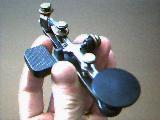
The Wizard key was made by D & K Manufacturing Co., of Cleveland, Ohio.
The Wizard was an add-on key intended to clip onto the main key and adapt
it to use by another operator who could adjust the Wizard to his own touch
without disturbing the adjustment of the main key in the line. The Wizard
Key was made circa 1908.
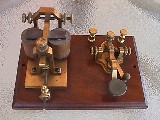
Tillotson keys are perhaps the easiest to date of the early landline
instruments, because Tillotson moved location frequently and imprinted the
new address on his keys. Roger Reinke's published list of American Telegraph
Instrument Makers 1837-1900 makes it easy to find the proper address and
therefore approximate date of manufacture. This camelback key is imprinted L.G. Tillotson and Co., 8 Dey St., New
York. It was made circa 1872-1880. I know of at least one beautiful
private line set made by L.G. Tillotson, currently in the collection of Tony
Rogozinski.
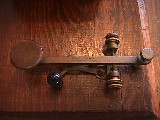
This is a Tillotson Straight Lever Key, also with the 8 Dey St. address on the lever, suggesting
it was made in the 1872-1880 period. This key is part of a box relay set. The support, the
contact, and the travel stop button are all separately assembled on the the board.

This is
a Tillotson Box Relay also from the 1872-1880 period. Notice the beautiful grain and cut to the wooden base.
The style of the key is nearly identical to the one on the KOB above.
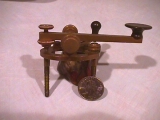 This is a
small sized Tillotson straight lever leg key. It is labeled "Tillotson & Co" on the lever, signifying manufacture
in the 1862-1865 time frame. This key has a hairpin spring.
This is a
small sized Tillotson straight lever leg key. It is labeled "Tillotson & Co" on the lever, signifying manufacture
in the 1862-1865 time frame. This key has a hairpin spring.
How Random Can Random Get?
This program asks your computer to generate random numbers between 1 and 100, and
then makes a real time bar graph of the numbers. The numbers go from 1 to 100 across the bottom. Each time a number is picked, the bar corresponding to that number grows a little taller. About 30 numbers are generated in a second by this program using JAVA's random number generator. Actually, it is very difficult to generate truly random numbers, and so they are sometimes called "pseudorandom" numbers. As you watch the bars grow, you can see that your computer does a pretty good job of finding random numbers, even if it's not perfect! Click the graph to start it over again.

This rear-pivot key is a miniature, 3 inches long by 1.25 inches wide.
It was made by the National Electric Manufacturing Company of New York,
circa 1890. It has a hairpin spring mechanism rather than a coiled
spring.
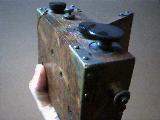
This is a Postal Telegraph Company Test set Key and sounder. It is
housed in a beautiful wooden box with brass corner protectors. The key
knob, adjustments, and connectors protrude through the sides of the box.
The workings inside are accessible through a hinged door on the side. Burned
into the inside of the door are the words Postal Tel. Co., Skirrow Patent,
May 17, 1904.
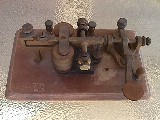
Jesse H. Bunnell began making telegraph equipment shortly
after the Civil War. This piece is dated May 4, 1877 and
represents an early style of Camelback key. The support pins
push into the lever arm, rather than the lever arm having pins
that extend into the support posts. Bunnell was probably the
most prolific manufacturer of telegraph instruments of the latter
19th century.
This lineman's test set was made by the Caton Instrument Shop of the
Illinois and Mississippi Telegraph Company. The Caton Shop made a general
line of telegraph equipment from 1851 to 1871 under James Gamble who was
its superintendent.
The tiny test set has ivory knobs and miniature hardware.
It has a small key and two covered coils packed into a small case.
The Caton Instrument Shop was located in Ottawa, Illinois.
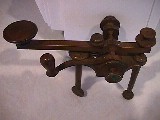 |
M.A. Buell made a general line of telegraph equipment in Cleveland,
Ohio, from about 1870-1884. The key on the left comes from Tim Patton, K4TJP. The inset
at the bottom is a magnified view of the lettering on the lever arm.
The number 1026 is also found on the lever arm, perhaps a serial number.
The knob is not original. The key on the right is a Buell straight lever
leg key. The spring tension is adjustable on this key. Buell telegraph keys are among the harder
to find keys made before the turn of the century. The sounders seem
to be somewhat easier to find.

A.S. Chubbuck made this beautiful key in Utica, New York between 1852 and
1869. The key sports a large safety pin type spring and no spring tension
adjustment screw. The shorting lever is on the left. The more common
arrangement is for the lever to be on the right. This key is marked not only
with the manufacturer's name, but also "A & S RR", the Alton and Southern
Railroad.

Partrick and Carter are best known for their lovely step lever keys. Some have spring
tension adjustment screws and some don't. This company was located at several addresses in
Philadelphia, PA, between about 1867 and 1897. By virtue of the japanned finish, this key was
likely originally part of a KOB.

This is a lovely Partrick & Carter private line set. Private line sets were frequently elegantly
adorned, and made with a more pleasing line than a regular KOB. They were generally apparently used in areas in which aesthetics were of concern, such as in a residence or small business.

This key was made by A.B. Lyman of Cleveland, Ohio. A.B. Lyman made keys from 1876 to 1880.
This particular model was called the A.B. Lyman Steel Lever Key. Lyman advertised it as "The Most
Perfect Key in the World." It certainly has a unique construction among telegraph keys, with two
metal straps meeting on the lever and acting as the spring. It is remotely reminiscent of the mechanism
on Steiner keys. The Lyman Steel Lever Key sold for $1!
Click the key in the diagram above to see how the basic landline
telegraph circuit worked. The key closes the mainline circuit
(highlighted in red with the mouse down on the key). Energizing
the mainline circuit causes the relay, which is nothing more than an
electromagnet, to close the local circuit (green) in a distant city. On long
telegraph lines the resistance of the wire employed is considerable and the
amount of current that the line battery can produce is not enough to cause
a loud click at the sounder (again, nothing more than an electromagnet). The relay is used so that the local battery
can supply enough juice to the sounder to make a nice loud "clack!".
The ground provides the return path for the mainline circuit. Adapted
from "The How and Why of Electricity" by Charles Tripler Child, 1902.
The Growth of Landline Telegraphy

This is a Knapp Electrical Works KOB. Little is known about this company other than that it was located in Chicago, Illinois as indicated on the label on the piece. There is fine gold artwork on the key and KOB.
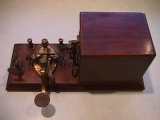
This is a beautiful box relay and key by the Co-operative Manufacturing Company of Philadelphia, PA. The key and hardware are nearly identical to Phelps pieces. This company produced telegraph instruments from 1871-1875 according to Roger Reinke's list.

This is a very beautiful cast iron desk set of very unusual construction and unknown maker. The key to the
right has a hairpin spring. The sounder housing is cast into the base and the sounder coil is completely hidden
to view. There is a pencil trough cast into the base. Please e-mail me if
you have information about the manufacturer of this key!








 This is a
small sized Tillotson straight lever leg key. It is labeled "Tillotson & Co" on the lever, signifying manufacture
in the 1862-1865 time frame. This key has a hairpin spring.
This is a
small sized Tillotson straight lever leg key. It is labeled "Tillotson & Co" on the lever, signifying manufacture
in the 1862-1865 time frame. This key has a hairpin spring.











 Back to the Index
Back to the Index